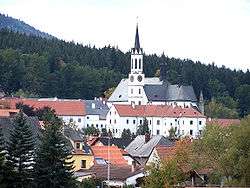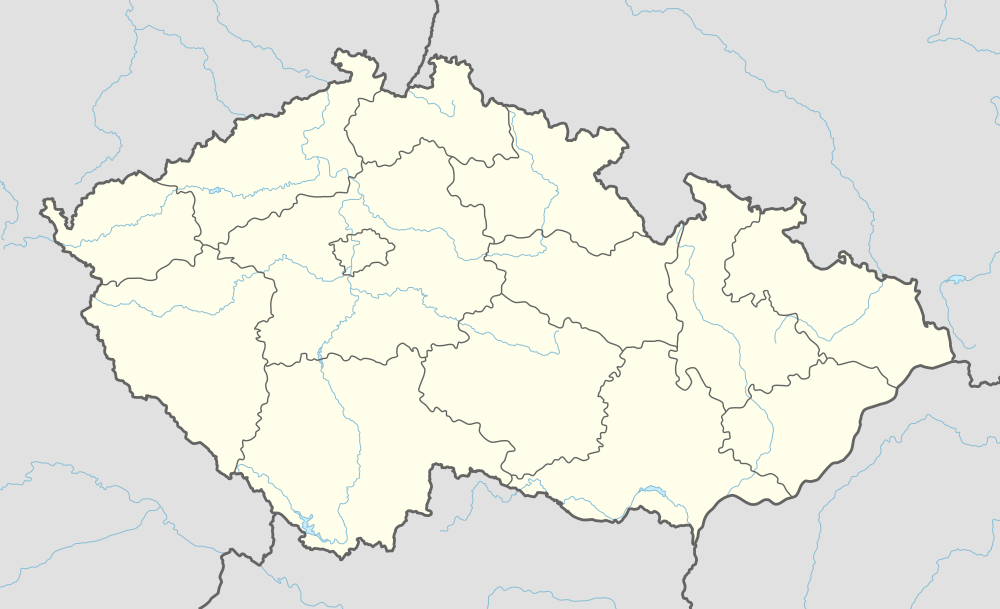Vyšší Brod
| Vyšší Brod | |||
|---|---|---|---|
| Town | |||
 | |||
| |||
 Vyšší Brod | |||
| Coordinates: 48°37′00″N 14°18′43″E / 48.61667°N 14.31194°ECoordinates: 48°37′00″N 14°18′43″E / 48.61667°N 14.31194°E | |||
| Country |
| ||
| Region | South Bohemian | ||
| District | Český Krumlov | ||
Vyšší Brod (Czech pronunciation: [ˈvɪʃiː ˈbrot] German: Hohenfurth) is a small town in the South Bohemian Region of the Czech Republic. It has around 2,600 inhabitants and it is the southernmost municipality in the Czech Republic. Vyšší Brod Monastery, an important historic landmark, is located in the town. The city has many tourists attractions like the Cistercian cloister, the Lake Lipno which connects to the Vltava River (which is one of the most popular canoeing route in the Czech Republic) and the historical town center.
The asteroid no. 121089, which was discovered in 1999 by Miloš Tichý from the observatory on Kleť, was named after the city.
History
The city extends around the already existent ford its place exceeded Vltava medieval merchant trail from Linz to Bohemia. The settlement was founded on the site of the latest in the 12th century and belonged to the Rosenberg dominion. In 1259 there Vok I. of Rosenberg founded together with the monks of the Cistercian monastery Wilhering and settlement with extensive grounds around them donated. Vyšší Brod received higher status by the decree of Emperor Franz Joseph I in 1870. In 1909, the town began initial building of the railway line between Rybník and Lipno nad Vltavouby by industrialists Arnošta Poráka and abbot Bruna Pammera, which was completed and opened in late 1911, ensure the city rail link.
In September 1938 the area became the site of heavy fighting between the Czechoslovak armed forces and German storm troops. On September 28, an attack by the Freikorps supported by local German residents to drive Czechoslovak forces off and by the next morning had to retreat to the left bank of the Vltava. Later that day, Czechoslovak reinforcements arrived, one bicycle company and another company by armored train enabling Czechoslovak forces to quickly retake the city. The Munich agreement later gave the Vyšebrodsko as well as other border regions to Germany.
The Nazis government occupied the cloister after expelling the monks who acted against them, and used it as a warehouse naloupených art and historical objects. The German occupation ended on May 6, 1945 with the arrival of the US Army, with which it had fought hopeless at the approaches to the city.
Most of the ethnic German population was expelled and was resettled by mostly non-native population in 1945. After the expulsion, most of the monks of German origin Vyšebrod restored the monastery. In 1950 the monastery was attacked by the State Security, who forcibly took it and sent the remaining monks to internment camps.
In 1959, the south of the city was part of the iron curtain, behind which there was only a small amount of the population in the villages Fountains and Lower Drkolná. After the opening of borders in 1989, the city's importance strongly grew due to the direct road to the border crossing at Studánky / Bad Leonfelden. A number of new accommodation and catering facilities were added including retail services (bakery, bookshop owners mostly Vietnamese), including a nightclubs. In 1990 the Monks returned to the monastery.
As of January 1, 2004 the city had a population of about 2,628 permanent residents.
Landmarks
- Vyšší Brod Monastery and its Church of the Assumption- Built in 1259 for the Order of Cistercians
- The parish church of St. Bartholomew
- The pilgrimage Church of Maria Rast am Stein
External links

- Municipal website (in Czech)

